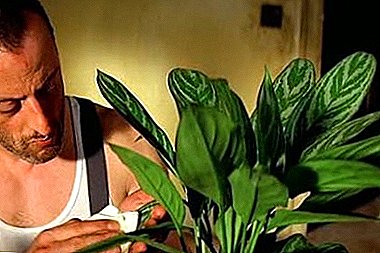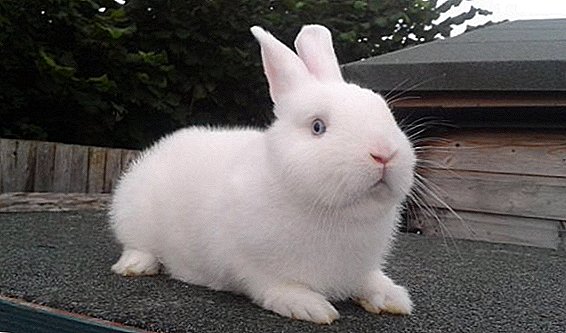 It happens that the domestic rabbit falls ill. External symptoms of this disease (curvature of the neck, loss of orientation, whitish dull eyes) indicate encephalosis. Consider how rabbit infection occurs with this disease, how to treat it and what preventive measures should be taken.
It happens that the domestic rabbit falls ill. External symptoms of this disease (curvature of the neck, loss of orientation, whitish dull eyes) indicate encephalosis. Consider how rabbit infection occurs with this disease, how to treat it and what preventive measures should be taken.
What kind of disease and how dangerous it is for rabbits
Encephalosis is a disease that is common in rabbits, the second name of the disease is torticollis. The disease is caused by a microscopic intracellular parasite of the microsporidium family. Usually the parasite infects rabbits, but guinea pigs, rodents, dogs, cats, monkeys and humans are also infected. 
How does the infection occur?
Most rabbits become infected from the urine of infected rabbits. Infection can occur within six weeks after birth. Also, an infected mother can infect her babies in utero. Spores, or the infectious form of the parasite, can penetrate along with the inhaled air.
Infected animals begin excretion of spores in the urine a month after infection, this discharge continues for two months from the start of infection. After three months, the selection of the dispute stops. Spores can live in the environment for up to six weeks at room temperature. The use of conventional disinfectants is very effective in inactivating spores.  After infection, the parasites spread along with the bloodstream to organs such as the lungs, liver and kidneys. The parasite multiplies in infected cells, which ultimately leads to their rupture. Cell rupture is the cause of chronic inflammation, which can be recognized by clinical signs.
After infection, the parasites spread along with the bloodstream to organs such as the lungs, liver and kidneys. The parasite multiplies in infected cells, which ultimately leads to their rupture. Cell rupture is the cause of chronic inflammation, which can be recognized by clinical signs.
When the parasite spreads in body tissues, antibodies develop in a living organism. This is what limits tissue damage and spore secretion. A healthy immune system prevents the parasite from reproducing, but disputes remain viable for many years. If in the future the rabbit will have weak immunity, these disputes can wake up and then lead to the development of the disease.
Did you know? Rabbits constantly have to gnaw something, as the teeth of these animals constantly continue to grow. If the animals had not gnawed (food, wood or stones), their teeth would have been 150 cm long after the animals reached the age of one year..
The first signs and progression of the disease
Infection with encephalosis can damage the eyes or the nervous system. 
Signs of defeat encephalosoniasis:
- strongly bowed head (vestibular disease);
- cataract on the eyes or inflammation of the fluid between the cornea and the lens (dull eyes);
- loss of orientation in space.
If the rabbit's immune system fails, the inflammation caused by the parasite's spores becomes more extensive. When inflammation is in the part of the brain that is responsible for the position of the head and balance, the main symptom will be an unnatural head tilt of the animal. A cataract caused by the disease can develop in one eye or both.
Did you know? The rabbit's heart makes from 130 to 325 beats per minute depending on the physical condition of the animal. For comparison: the sound of a healthy human heart is from 60 to 100 beats per minute.Sometimes the inflammatory process caused by the parasite affects the areas of the brain or nerves.

At the same time, more specific signs appear:
- difficulty chewing or eating during meals;
- changes in the location of the legs;
- paralysis or weakness of the hind legs;
- uncontrolled urination because the disease affects the nerves that control the bladder.
Did you know? In the Middle Ages in France, rabbits were considered fish. In a strict fasting, the church allows fish to be eaten, so the monks could eat rabbit meat.
In other rabbits infected with encephalosis, the external symptoms of the disease may be vague, but the animals will have poor appetite, weight loss or drowsiness, rapid intermittent breathing, excessive fatigue. To more accurately diagnose, a sick animal should be shown to a veterinarian, as well as to conduct a diagnostic test to determine encephalosis.
Diagnostics
In this case, the disease is not always the correct diagnosis, as other diseases may have similar symptoms, and diagnostic testing is quite expensive. Sometimes a rabbit can have a lifelong infection of kidney encephalosis, and the kidneys look completely healthy and do a good job with their functions, because the changes caused by microsporidia are minor.  To confirm the infection, it is necessary to do specialized diagnostic tests, such as polymerase chain reaction (PCR) tests for the detection of DNA encephalosis. Veterinarians usually suspect encephalosis, based on changes in the eyes, posture, movements or other neurological abnormalities.
To confirm the infection, it is necessary to do specialized diagnostic tests, such as polymerase chain reaction (PCR) tests for the detection of DNA encephalosis. Veterinarians usually suspect encephalosis, based on changes in the eyes, posture, movements or other neurological abnormalities.
The method of polymerase chain reaction of urine and the study of feces will help to find the DNA of encephalosis and confirm that there are disputes in the body of the rabbit. A better diagnostic test includes blood tests for two different tests:
- enzyme immunoassay, which measures the levels of antibodies to encephalosis,
- protein electrophoresis, which evaluates the types of proteins in rabbit blood.
Learn how to treat rabbit diseases and whether they pose a threat to human health.
An enzyme immunoassay shows whether the rabbit has been exposed to the parasite, while protein electrophoresis can distinguish whether the disease is active or is in a latent stage. Computed tomography (CT) or magnetic resonance imaging (MRI) can detect brain lesions.
Although these tests cannot confirm encephalosis as a cause of damage, they can tell by the location and size of the brain lesions whether the animal can be cured and whether the rabbit will have permanent neurological problems in the future.
Did you know? Rabbits purr when satisfied. This sound is not like a cat's purr, rather, it sounds like a light scratching of teeth or a quiet chewing. Every rabbit owner knows how comfortable this sound is.
The disadvantage is that these tests require the animal to undergo anesthesia (which is quite expensive) and can miss minor injuries that cause profound changes in the behavior and health of the rabbit. Also, MRI and tomography are used to compare the normal anatomy of the rabbit brain with the image obtained from a sick animal. 
How to treat
The veterinarian may recommend treatment with Fenbendazole for 28 days. Non-steroidal anti-inflammatory drugs may be used. Corticosteroids are also used as an alternative to nonsteroidal anti-inflammatory drugs. In case of secondary infection, antibiotics will be prescribed.
Sometimes there are cases when the rabbit does not respond to treatment or partially reacts, and the animal remains some changes in the central nervous system. Rabbits with residual effects may have a constant head tilt or partial loss of mobility. In some cases (urinary incontinence, paralysis), it is recommended to sleep the animal.
Read also about how to care for rabbits and how to feed them.
Veterinary drugs
Therapy for encephalosis
- "Fenbendazol" - 20 mg per kilogram of live weight, daily, orally, a course of treatment for 28 days.
- "Dexamethasone" - 0.2 mg per 1 kg of live weight, subcutaneous injection or oral administration, once a day.
- Antibiotic "Chloramphenicol" - 30 mg per pound of live weight twice a day, subcutaneous injections for 14 days.
- "Enrofloxacin" - 10 mg per 1 kg of live weight, once a day for 14 days, orally or as a subcutaneous infection.
- "Oxytetracycline" - 20 mg per 1 kg of live weight, subcutaneously once a day, the course of treatment - 14 days.
- "Marbofloxacin" - 4 mg per 1 kg of live weight once a day for 14 days, administered orally or subcutaneously.
- "Trimethoprim", "Sulfonamide" - 20 mg per kilogram of body weight once a day, the course of treatment is 14 days, injected subcutaneously.
- The complex of vitamins of group B - 0.5-1.0 ml per 1 kg of live weight, subcutaneously, once a day, the course of treatment is 14 days.
- A crystalloid solution (for example, "Sterofundin") in the form of droppers - 20-40 mg per kilogram of live weight once a day for the first 3 days, then every 2 day for 10 days, is administered intravenously or subcutaneously.
- Prevention of the formation of bedsores - use in the right places ointments based on tetracycline or cortisone.

Also in severe cases, it is necessary to apply physical therapy and forced supplementation.
Did you know? Rabbits are very fast animals, in the wild, their speed reaches 38 kilometers per hour.
Cell disinfection
For disinfection of all cell surfaces, as well as feeders, drinkers and other equipment they are treated with disinfecting solutions. As a disinfectant used:
- cool boiling water;
- 70% alcohol solutions;
- 1% formaldehyde solution;
- 2% solution of lysol.
Important! In no case should you try to straighten the rabbit with the help of physical strength, it will damage the animal.
Care, feeding and watering
- A sick animal is prone to panic attacks, during which it can accidentally inflict damage to itself. To prevent this from happening, the walls of the rabbit cage are preferably covered with soft materials, do not frighten the animal with harsh and loud sounds, and gently and quietly talk to it. During the illness of a pet, they do not stop communication, the animal badly needs a caress.
- Water for drinking the patient is poured into a shallow saucer and set on the floor of the cage. If the patient is not able to get drunk on his own, he is watered with water collected in a syringe, in especially severe cases the physical solution is injected into the animal subcutaneously.
- If the animal has completely lost its appetite, then it must be fed by force, which can be difficult to do with a crooked neck.
- The litter, water, and food in the sick rabbit's cage are changed to fresh once a day.

Is encephalosis given to man?
Rabbits with good immunity, as well as fully fed, can remain latent carriers of the spores and outwardly have no signs of the disease at all, or carry the disease in mild form. It is important to know that E. cuniculi is a contagious disease, that is, people can also become infected with this parasite. Usually, those who have a very weakened immune system, such as those with AIDS, are the first to become ill.  Spores are emitted from the body of the diseased animal, which a healthy person can inhale with the air. This is the way of infection of human rabbit with encephalosis. Be sure to wash your hands after contact with a pet, and also keep your rabbit and his cage clean.
Spores are emitted from the body of the diseased animal, which a healthy person can inhale with the air. This is the way of infection of human rabbit with encephalosis. Be sure to wash your hands after contact with a pet, and also keep your rabbit and his cage clean.
Prevention
For the purpose of prophylaxis, twice a year, the animal periodically (every 35-40 days or twice a year) is given Fenbendazol, which has anthelmintic properties, exactly following the dosage specified in the instructions. You also need to pay special attention to sanitation: the cleanliness of the rabbit cage, as well as the cleanliness of the premises for people where there is a rabbit. It is desirable to minimize the contact of the rabbit with other people's animals.
Important! Some sources indicate the need to carry out a prophylactic course of treatment every 35-40 days, while others indicate the semiannual interval between taking the medicine. To more accurately determine how to prevent the disease, the pet owner is advisable to seek the advice of a veterinarian.Veterinarians claim that almost any rabbit who has ever been in contact with their relatives is infected with encephalosis. In animals with weak immunity, the disease manifests itself and progresses, and strong healthy animals may not be ill all their life, but they carry the spores of this parasite in the body and at the slightest weakening of their health they are at risk of getting sick. In order for a pet to be strong and healthy, it is necessary to regularly conduct preventive treatment.
Reviews














